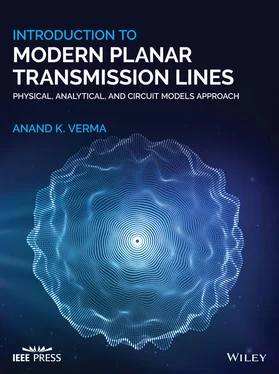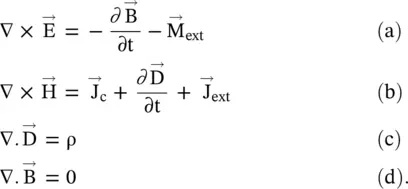Anand K. Verma - Introduction To Modern Planar Transmission Lines
Здесь есть возможность читать онлайн «Anand K. Verma - Introduction To Modern Planar Transmission Lines» — ознакомительный отрывок электронной книги совершенно бесплатно, а после прочтения отрывка купить полную версию. В некоторых случаях можно слушать аудио, скачать через торрент в формате fb2 и присутствует краткое содержание. Жанр: unrecognised, на английском языке. Описание произведения, (предисловие) а так же отзывы посетителей доступны на портале библиотеки ЛибКат.
- Название:Introduction To Modern Planar Transmission Lines
- Автор:
- Жанр:
- Год:неизвестен
- ISBN:нет данных
- Рейтинг книги:4 / 5. Голосов: 1
-
Избранное:Добавить в избранное
- Отзывы:
-
Ваша оценка:
Introduction To Modern Planar Transmission Lines: краткое содержание, описание и аннотация
Предлагаем к чтению аннотацию, описание, краткое содержание или предисловие (зависит от того, что написал сам автор книги «Introduction To Modern Planar Transmission Lines»). Если вы не нашли необходимую информацию о книге — напишите в комментариях, мы постараемся отыскать её.
rovides a comprehensive discussion of planar transmission lines and their applications, focusing on physical understanding, analytical approach, and circuit models
Planar transmission lines form the core of the modern high-frequency communication, computer, and other related technology. This advanced text gives a complete overview of the technology and acts as a comprehensive tool for radio frequency (RF) engineers that reflects a linear discussion of the subject from fundamentals to more complex arguments.
Introduction to Modern Planar Transmission Lines: Physical, Analytical, and Circuit Models Approach Emphasizes modeling using physical concepts, circuit-models, closed-form expressions, and full derivation of a large number of expressions Explains advanced mathematical treatment, such as the variation method, conformal mapping method, and SDA Connects each section of the text with forward and backward cross-referencing to aid in personalized self-study
is an ideal book for senior undergraduate and graduate students of the subject. It will also appeal to new researchers with the inter-disciplinary background, as well as to engineers and professionals in industries utilizing RF/microwave technologies.

 ), electric displacement current density
), electric displacement current density  , and magnetic displacement current density
, and magnetic displacement current density  to the magnetic field (
to the magnetic field (  and the electric field (
and the electric field (  respectively:
respectively:
 ,
,  , and
, and  are not the power supplying sources to the propagating EM‐wave in a medium. These current densities are created by the externally applied magnetic and electric current densities
are not the power supplying sources to the propagating EM‐wave in a medium. These current densities are created by the externally applied magnetic and electric current densities  and
and  supplying power to the EM‐wave and partly getting absorbed as loss in a conducting medium.
supplying power to the EM‐wave and partly getting absorbed as loss in a conducting medium. ,
,  ), flux field quantities (
), flux field quantities (  ), and current densities are functions of both the space variables and time variable. Further, in any material medium, the flux field quantities are related to the force field quantities by the constitutive relations, given in equation (4.1.7). The conduction current density in a lossy medium is related to the electric field, as given in equation (4.1.9).
), and current densities are functions of both the space variables and time variable. Further, in any material medium, the flux field quantities are related to the force field quantities by the constitutive relations, given in equation (4.1.7). The conduction current density in a lossy medium is related to the electric field, as given in equation (4.1.9).


 is exerted either on a moving or on a stationary charge in the static, or in the time‐varying electric field. The magnetic force
is exerted either on a moving or on a stationary charge in the static, or in the time‐varying electric field. The magnetic force 
 is exerted only on a moving charge in the static, or in the time‐varying, magnetic field. In the case of a time‐varying electric, or the time‐varying magnetic field, both fields are always present and are related through Maxwell’s equations (4.4.1a) and (4.4.1b). Thus, both components of Lorentz's force are present on a moving charge in a time‐varying EM‐field.
is exerted only on a moving charge in the static, or in the time‐varying, magnetic field. In the case of a time‐varying electric, or the time‐varying magnetic field, both fields are always present and are related through Maxwell’s equations (4.4.1a) and (4.4.1b). Thus, both components of Lorentz's force are present on a moving charge in a time‐varying EM‐field. ) creates a time‐varying magnetic field . Thus, Maxwell’s equations (4.4.1a)and (4.4.1b)form a set of the coupled equations, showing an interdependence of the time‐varying electric and magnetic fields. It is like the two‐variable simultaneous equations that occur in ordinary algebra. However, in the present case, the field variables (
) creates a time‐varying magnetic field . Thus, Maxwell’s equations (4.4.1a)and (4.4.1b)form a set of the coupled equations, showing an interdependence of the time‐varying electric and magnetic fields. It is like the two‐variable simultaneous equations that occur in ordinary algebra. However, in the present case, the field variables (  ,
,  are vector quantities. The coupled partial differential equations are solved either for the
are vector quantities. The coupled partial differential equations are solved either for the  or
or  by following the rules of the vector algebra. The solutions provide the wave equation either for the electric (
by following the rules of the vector algebra. The solutions provide the wave equation either for the electric (  ) or for the magnetic (
) or for the magnetic (  ) field.
) field.










